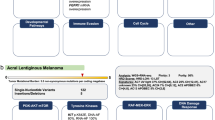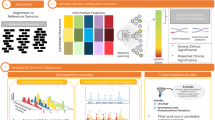Abstract
Translating whole-exome sequencing (WES) for prospective clinical use may have an impact on the care of patients with cancer; however, multiple innovations are necessary for clinical implementation. These include rapid and robust WES of DNA derived from formalin-fixed, paraffin-embedded tumor tissue, analytical output similar to data from frozen samples and clinical interpretation of WES data for prospective use. Here, we describe a prospective clinical WES platform for archival formalin-fixed, paraffin-embedded tumor samples. The platform employs computational methods for effective clinical analysis and interpretation of WES data. When applied retrospectively to 511 exomes, the interpretative framework revealed a 'long tail' of somatic alterations in clinically important genes. Prospective application of this approach identified clinically relevant alterations in 15 out of 16 patients. In one patient, previously undetected findings guided clinical trial enrollment, leading to an objective clinical response. Overall, this methodology may inform the widespread implementation of precision cancer medicine.
This is a preview of subscription content, access via your institution
Access options
Subscribe to this journal
Receive 12 print issues and online access
$209.00 per year
only $17.42 per issue
Buy this article
- Purchase on Springer Link
- Instant access to full article PDF
Prices may be subject to local taxes which are calculated during checkout





Similar content being viewed by others
References
Garraway, L.A. & Lander, E.S. Lessons from the cancer genome. Cell 153, 17–37 (2013).
Garraway, L.A. Genomics-driven oncology: framework for an emerging paradigm. J. Clin. Oncol. 31, 1806–1814 (2013).
Garraway, L.A. & Janne, P.A. Circumventing cancer drug resistance in the era of personalized medicine. Cancer Discov. 2, 214–226 (2012).
Thomas, R.K. et al. High-throughput oncogene mutation profiling in human cancer. Nat. Genet. 39, 347–351 (2007).
MacConaill, L.E. et al. Profiling critical cancer gene mutations in clinical tumor samples. PLoS ONE 4, e7887 (2009).
Dias-Santagata, D. et al. Rapid targeted mutational analysis of human tumours: a clinical platform to guide personalized cancer medicine. EMBO Mol. Med. 2, 146–158 (2010).
Wagle, N. et al. High-throughput detection of actionable genomic alterations in clinical tumor samples by targeted, massively parallel sequencing. Cancer Discov. 2, 82–93 (2012).
Lipson, D. et al. Identification of new ALK and RET gene fusions from colorectal and lung cancer biopsies. Nat. Med. 18, 382–384 (2012).
Beltran, H. et al. Targeted next-generation sequencing of advanced prostate cancer identifies potential therapeutic targets and disease heterogeneity. Eur. Urol. 63, 920–926 (2013).
Roychowdhury, S. et al. Personalized oncology through integrative high-throughput sequencing: a pilot study. Sci. Transl. Med. 3, 111ra121 (2011).
Craig, D.W. et al. Genome and transcriptome sequencing in prospective metastatic triple-negative breast cancer uncovers therapeutic vulnerabilities. Mol. Cancer Ther. 12, 104–116 (2013).
Kerick, M. et al. Targeted high throughput sequencing in clinical cancer settings: formaldehyde fixed-paraffin embedded (FFPE) tumor tissues, input amount and tumor heterogeneity. BMC Med. Genomics 4, 68 (2011).
Goetz, L., Bethel, K. & Topol, E.J. Rebooting cancer tissue handling in the sequencing era: toward routine use of frozen tumor tissue. J. Am. Med. Assoc. 309, 37–38 (2013).
Fisher, S. et al. A scalable, fully automated process for construction of sequence-ready human exome targeted capture libraries. Genome Biol. 12, R1 (2011).
Gerlinger, M. et al. Intratumor heterogeneity and branched evolution revealed by multiregion sequencing. N. Engl. J. Med. 366, 883–892 (2012).
Pao, W., Ladanyi, M. & Miller, V.A. Erlotinib in lung cancer. N. Engl. J. Med. 353, 1739–1741 (2005).
Williams, C. et al. A high frequency of sequence alterations is due to formalin fixation of archival specimens. Am. J. Pathol. 155, 1467–1471 (1999).
Spencer, D.H. et al. Comparison of clinical targeted next-generation sequence data from formalin-fixed and fresh-frozen tissue specimens. J. Mol. Diagn. 15, 623–633 (2013).
Cibulskis, K. et al. Sensitive detection of somatic point mutations in impure and heterogeneous cancer samples. Nat. Biotechnol. 31, 213–219 (2013).
Imielinski, M. et al. Mapping the hallmarks of lung adenocarcinoma with massively parallel sequencing. Cell 150, 1107–1120 (2012).
Banerji, S. et al. Sequence analysis of mutations and translocations across breast cancer subtypes. Nature 486, 405–409 (2012).
Hodis, E. et al. A landscape of driver mutations in melanoma. Cell 150, 251–263 (2012).
Barbieri, C.E. et al. Exome sequencing identifies recurrent SPOP, FOXA1 and MED12 mutations in prostate cancer. Nat. Genet. 44, 685–689 (2012).
Stransky, N. et al. The mutational landscape of head and neck squamous cell carcinoma. Science 333, 1157–1160 (2011).
Lohr, J.G. et al. Discovery and prioritization of somatic mutations in diffuse large B-cell lymphoma (DLBCL) by whole-exome sequencing. Proc. Natl. Acad. Sci. USA 109, 3879–3884 (2012).
Cheung, H.W. et al. Amplification of CRKL induces transformation and epidermal growth factor receptor inhibitor resistance in human non-small cell lung cancers. Cancer Discov. 1, 608–625 (2011).
Natsume, H. et al. The CRKL gene encoding an adaptor protein is amplified, overexpressed, and a possible therapeutic target in gastric cancer. J. Transl. Med. 10, 97 (2012).
Janakiraman, M. et al. Genomic and biological characterization of exon 4 KRAS mutations in human cancer. Cancer Res. 70, 5901–5911 (2010).
Carretero, J. et al. Integrative genomic and proteomic analyses identify targets for Lkb1-deficient metastatic lung tumors. Cancer Cell 17, 547–559 (2010).
Forbes, S.A. et al. COSMIC: mining complete cancer genomes in the Catalogue of Somatic Mutations in Cancer. Nucleic Acids Res. 39, D945–D950 (2011).
Ding, L. et al. Somatic mutations affect key pathways in lung adenocarcinoma. Nature 455, 1069–1075 (2008).
Govindan, R. et al. Genomic landscape of non-small cell lung cancer in smokers and never-smokers. Cell 150, 1121–1134 (2012).
Puyol, M. et al. A synthetic lethal interaction between K-Ras oncogenes and Cdk4 unveils a therapeutic strategy for non-small cell lung carcinoma. Cancer Cell 18, 63–73 (2010).
Levine, R.L. JAK-mutant myeloproliferative neoplasms. Curr. Top. Microbiol. Immunol. 355, 119–133 (2012).
Boggon, T.J., Li, Y., Manley, P.W. & Eck, M.J. Crystal structure of the Jak3 kinase domain in complex with a staurosporine analog. Blood 106, 996–1002 (2005).
Malinge, S. et al. Activating mutations in human acute megakaryoblastic leukemia. Blood 112, 4220–4226 (2008).
Gonzalez-Angulo, A.M., Hennessy, B.T. & Mills, G.B. Future of personalized medicine in oncology: a systems biology approach. J. Clin. Oncol. 28, 2777–2783 (2010).
Yeh, P. et al. DNA-mutation Inventory to Refine and Enhance Cancer Treatment (DIRECT): a catalogue of clinically relevant cancer mutations to enable genome-directed cancer therapy. Clin. Cancer Res. 19, 1894–1901 (2013).
Cerami, E. et al. The cBio cancer genomics portal: an open platform for exploring multidimensional cancer genomics data. Cancer Discov. 2, 401–404 (2012).
Reich, M. et al. GenePattern 2.0. Nat. Genet. 38, 500–501 (2006).
Cibulskis, K. et al. ContEst: estimating cross-contamination of human samples in next-generation sequencing data. Bioinformatics 27, 2601–2602 (2011).
Drier, Y. et al. Somatic rearrangements across cancer reveal classes of samples with distinct patterns of DNA breakage and rearrangement-induced hypermutability. Genome Res. 23, 228–235 (2013).
Chiang, D.Y. et al. High-resolution mapping of copy-number alterations with massively parallel sequencing. Nat. Methods 6, 99–103 (2009).
Olshen, A.B., Venkatraman, E.S., Lucito, R. & Wigler, M. Circular binary segmentation for the analysis of array-based DNA copy number data. Biostatistics 5, 557–572 (2004).
Pruitt, K.D., Tatusova, T., Klimke, W. & Maglott, D.R. NCBI reference sequences: current status, policy and new initiatives. Nucleic Acids Res. 37, D32–D36 (2009).
Futreal, P.A. et al. A census of human cancer genes. Nat. Rev. Cancer 4, 177–183 (2004).
Subramanian, A. et al. Gene set enrichment analysis: a knowledge-based approach for interpreting genome-wide expression profiles. Proc. Natl. Acad. Sci. USA 102, 15545–15550 (2005).
Gehlenborg, N., Noble, M.S., Getz, G., Chin, L. & Park, P.J. Nozzle: a report generation toolkit for data analysis pipelines. Bioinformatics 29, 1089–1091 (2013).
Acknowledgements
We thank the patients and clinicians for their participation in this project. We thank the Broad Genomics Platform (specifically K. Anderka, A. Cheney, E. Wheeler, T. Mason and C. Crawford). We thank C. Sougnez for facilitating data deposition. We also thank A. Lane and A. Yoda (Dana-Farber Cancer Institute), for their contributions to the JAK3 experimental work: A. Lane provided Ba/F3 cells, and A. Yoda provided murine stem cell virus–puromycin vector. G.G. is partially funded by a Paul C. Zamecnik, MD, Chair in Oncology at Massachusetts General Hospital. This work was supported by the Starr Cancer Foundation (L.A.G.), the Prostate Cancer Foundation (E.M.V.A. and L.A.G.), US National Institutes of Health (NIH) NHGRI Clinical Sequencing Exploratory Research grant 1U01HG006492 (L.A.G.), the NIH National Cancer Institute grant 1U24CA126546 (L.A.G. and E.S.L.), the US Department of Defense (L.A.G.), NIH U24CA143845 grant (G.G.) and the Dana-Farber Leadership Council (E.M.V.A.).
Author information
Authors and Affiliations
Contributions
All authors contributed extensively to the work presented in this paper. E.M.V.A. and N.W. contributed equally to this work. S.G., G.G. and L.A.G. contributed equally to this work. D.L.P., D.C.F., J.F., E.S.L., S.A.F., E.M.V.A. and S.G. contributed to FFPE sample sequencing protocols and analysis of sequencing metrics. E.M.V.A., P.S., D.F., K.C., G.K., S.L.C., A.M., A.S., A.K., D.V., M.L., L.T.L., J.G.G., M.R. and G.G. contributed to computational analyses for FFPE versus frozen sample comparisons and analysis of WES data generally. E.M.V.A., N.W., G.K., F.W.H., S.W.G., S.J., P.J., J.G., L.M., N.L., B.R., P.K. and L.A.G. contributed to clinical analysis and interpretation methods and application. N.W., S.M., J.J.-V. and L.A.G. contributed to experimental follow-up of the JAK3 mutation. D.B. and L.G. contributed clinical input for the patient case. All authors discussed the results and implications and commented on the manuscript at all stages.
Corresponding authors
Ethics declarations
Competing interests
L.A.G. and N.W. are equity holders and consultants in Foundation Medicine. L.A.G. is a consultant to Novartis, Millenium/Takeda and Boehringer Ingelheim and a recipient of a grant from Novartis. G.G. is a consultant to The Kew Group. D.B. is a consultant to N-of-1.
Supplementary information
Supplementary Text and Figures
Supplementary Figures 1–6 (PDF 18074 kb)
Supplementary Note
Supplementary Note (PDF 301 kb)
Supplementary Table 1
Supplementary Table 1 (XLSX 825 kb)
Supplementary Table 2
Supplementary Table 2 (TXT 1 kb)
Supplementary Table 3
Supplementary Table 3 (TXT 0 kb)
Supplementary Table 4
Supplementary Table 4 (XLSX 47 kb)
Supplementary Table 5
Supplementary Table 5 (XLSX 36 kb)
Supplementary Table 6
Supplementary Table 6 (XLSX 35 kb)
Supplementary Table 7
Supplementary Table 7 (XLSX 43 kb)
Supplementary Table 8
Supplementary Table 8 (DOCX 15 kb)
Supplementary Table 9
Supplementary Table 9 (XLSX 28 kb)
Rights and permissions
About this article
Cite this article
Van Allen, E., Wagle, N., Stojanov, P. et al. Whole-exome sequencing and clinical interpretation of formalin-fixed, paraffin-embedded tumor samples to guide precision cancer medicine. Nat Med 20, 682–688 (2014). https://doi.org/10.1038/nm.3559
Received:
Accepted:
Published:
Issue Date:
DOI: https://doi.org/10.1038/nm.3559
This article is cited by
-
Computational approaches to modelling and optimizing cancer treatment
Nature Reviews Bioengineering (2023)
-
Molecular tumour boards — current and future considerations for precision oncology
Nature Reviews Clinical Oncology (2023)
-
Actionability classification of variants of unknown significance correlates with functional effect
npj Precision Oncology (2023)
-
Optimizing Patient Pathways in Advanced Biliary Tract Cancers: Recent Advances and a French Perspective
Targeted Oncology (2023)
-
Comprehensive analysis of the autophagy-dependent ferroptosis-related gene FANCD2 in lung adenocarcinoma
BMC Cancer (2022)



